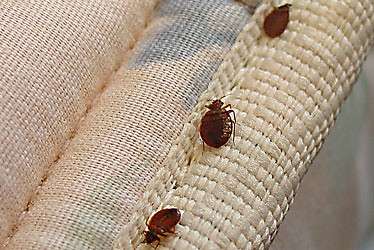Are you a fan of thrift shopping? or Facebook Marketplace? Me too, I love a good deal on used items! It’s often better for the environment to buy used as well. But it is important to know of the invasive pests that could be lurking in second-hand items. Pests transfer from home to home through second-hand items, and other methods. So read this guide to learn of the 9 invasive hitchhikers in second-hand finds. Don’t play pest roulette! Know the facts!
Table of Contents
- 9 Invasive Hitchhikers in Second-Hand Finds
- How We Treat these 9 Invasive Pests
- Conclusion & Next Steps
9 Invasive Hitchhikers in Second-Hand Finds
While it can be fun to go thrift shopping, ordering online, buying from Facebook Marketplace, it is also important to be aware of the pests that could be hiding in those second-hand items. Pests transfer in more ways than just second-hand items. In fact, we made a list of how bed bugs spread, especially. The same is true for the bugs listed in this guide too.
Invasive pests can spread through second-hand items, and being aware of these pests can help in preventing their introduction into new environments. Here’s a list of 9 invasive pests that can spread through used or second-hand items:
1. Bed Bugs (Cimex lectularius): As mentioned earlier, bed bugs are notorious hitchhikers and can easily transfer through infested furniture like mattresses, sofas, and chairs. Bed bugs can even spread through moving in and out of dorm rooms, and it’s important to know what to look for. Check out our Complete Bed Bug Guide for more information on how to prevent bed bug transmission.
2. Cockroaches: Various species of cockroaches, such as German cockroaches, the most common type of invasive cockroach in Minnesota, or Oriental cockroaches, can hide in used furniture and spread to new environments. Since cockroaches can be so difficult to eradicate for the average person, it is important to prevent cockroach infestations. Preventing pest spread is the most proactive pest control method there is.
For a free quote on pest control services, call 651-342-9489!
3. Termites: Infested wooden furniture, especially if it has hidden termite colonies, can introduce these destructive pests to new locations. While termites are typically not in Minnesota, it doesn’t mean they aren’t a threat. Termites can be transferred to MN, they just won’t be able to survive the winter. But why take the risk? If you think you have termites, why not get them inspected with our wood destroying insect inspection? Call now for a free quote: 651-342-9489.
Don’t take the risk of termites being in your used goods. Get proactive pest control now, for residential homes, commercial buildings, and apartment complexes!
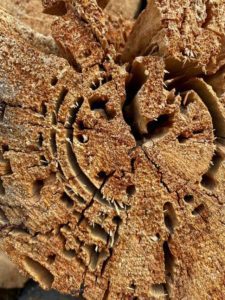
4. Carpet Beetles: These insects can infest upholstered furniture, carpets, and other fabric materials, and they may be transported through second-hand items made of these materials. Carpet beetles are common hitchhiking pests, and they can be destructive since the larvae eats these materials listed above. Since carpet beetles can commonly infest used furniture, it’s important to know what to look for in preventing pest spread.
5. Wood-Boring Insects: Beetles like powderpost beetles or wood borers can lay eggs in wooden furniture or structures, potentially spreading to new locations if the infested items are moved. Wood-boring beetles, if gone untreated, can become as destructive as carpenter ants. Give Done Right Pest Solutions a call for a free quote on wood destroying insect inspections: 651-342-9489.
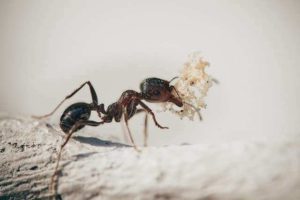
6. Clothes Moths: These pests can infest and damage fabrics like wool, fur, or silk. Second-hand clothing or upholstery items made from these materials can transport clothes moths. With thorough inspection, efficient and effective treatment, peace of mind monitoring devices, and a warrantied service, why would you not use Done Right Pest Solutions for all of your clothing moths pest control needs?
7. Fleas: Second-hand items like pet bedding or upholstered furniture can carry fleas, especially if the previous owners had pets. Fleas were the pest of the year in 2021. Maybe it was due to everyone (including their pets) being pent up for long periods of time due to Covid. But we saw a lot of flea services that year, and it helped us get better at honing our craft.
Because fleas are common hitchhiking pests, avoid infested furniture. And if there is a chance you brought some home, give Done Right Pest Solutions a call for a free quote and phone consultation: 651-342-9489.
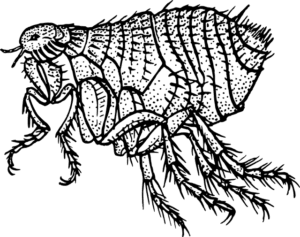

8. Spiders: While not all spiders are harmful, some species might inadvertently be transported through second-hand items like storage boxes, furniture, or clothing. Avoid bringing home spiders, as you don’t know if one will lay an egg sack or not.
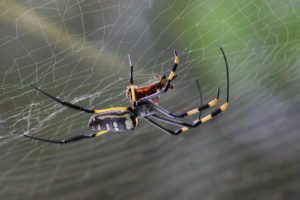

9. Ants: Certain ant species can establish colonies in furniture, particularly those made of wood or containing food residue, and can spread when these items are moved. Finally, ants can be invasive pests. Common ants and pavement ants are more of a nuisance than destructive, but over time if pavement ants are not dealt with, large colonies can cause homes to settle awkwardly. Pharoah ants can transmit diseases within hospitals and can be super hard for the average homeowner to treat due to their different colony structure. And carpenter ants can be crazy destructive to homes.
Preventing the spread of invasive pests through second-hand items involves careful inspection, cleaning, and, if necessary, treatment before introducing these items into a new environment. It’s also essential to be cautious and aware of the signs of infestation to minimize the risk of inadvertently transporting these pests.
Now you’ve learned the list of 9 invasive pests in second-hand items, you’ve learned about how pests transfer from these second-hand items to your home, and you’ve learned the importance of preventing pest spread and avoiding infested furniture. Read on to learn how we treat these 9 invasive pests!
Are you moving soon? If so, check out our Moving Guide: 32 Tips for Keeping Your Space Pest Free!
How We Treat These 9 Invasive Pests
Professional pest control technicians employ various methods and treatments to address different types of pests. Read on to learn how we treat these 9 invasive pests. Ultimately a full inspection is always performed prior to any products are used. It is important we diagnose the issue and identify the pest prior to treatment in order to ensure the correct products are used.
Here’s how they might typically handle the pests listed:
- 1. Bed Bugs:
- Inspection: Technicians first conduct a thorough inspection to identify bed bug hiding spots. Bed bugs are really good at hiding in wall voids and out of sight. It is important to learn the warning signs of bed bugs.
- Treatment: Our technicians use a quality chemical product that does not waft into the air and is not lingering. We never require any prep work, nor do we require anyone to leave their home. If we need to use a harsher product, it would be on a follow-up date with adequate notice, but this is rare.
- At least 1, 2-week follow-up is necessary and a 3 month warranty is given. And once you know the signs of bed bugs, it’s easier to prevent bed bug transmission and prevent pest spread.
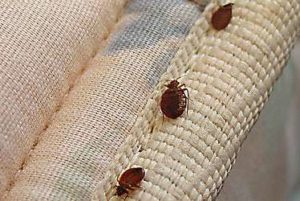

- 2. Cockroaches:
- Baiting and Spraying: Technicians may use insecticidal baits, sprays, or dusts targeted at cockroach hiding spots.
- Crack and Crevice Treatment: Our technicians apply treatments in cracks, crevices, and other areas where cockroaches hide.
- At least 1, 2-week follow-up is necessary and a 3 month warranty is given.
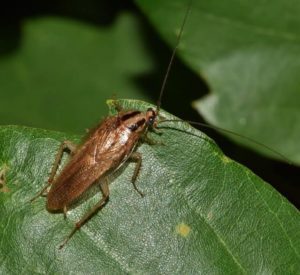

- 3. Termites:
- Soil Treatment: Licensed pest control technicians apply liquid termiticides around the perimeter of a structure to create a barrier against termites.
- Wood Treatment: Technicians may treat infested wood with termiticides or using foam or dust formulations to reach termite colonies.
- As noted above, there have not been any termite cases in Minnesota since the 1980s. They are very rare due to the pre-treatments of construction materials. Still, the soil treatment as noted is how we would treat carpenter ants.
For a free quote on pest control services, call 651-342-9489!
- 4. Carpet Beetles:
- Vacuuming: Thorough vacuuming to remove larvae, adults, and eggs. It has been known that vacuuming alone can eradicate both carpet beetles and fleas, though it is very time consuming and takes weeks to months to get all of the eggs to hatch.
- Insecticide Treatment: Our licensed technicians will apply insecticides to affected areas or using insecticidal dusts in voids where beetles might hide.
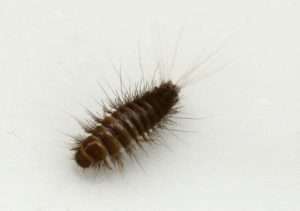

- 5. Wood-Boring Insects:
- Fumigation: For severe infestations, fumigation may be used to eliminate wood-boring insects, but typically an exterior foundational spray can be applied to eradicate wood-boring beetles and carpenter ants.
- Wood Preservatives: It is customary for manufacturers to have treated wooden structures or furniture with wood preservatives to prevent future infestations.
- 6. Clothes Moths:
- Dry Cleaning: Professional dry cleaning of infested clothing or fabrics. This may be a proactive measure, but we typically do not advocate for any removal of items until all pests have been eliminated. Once clothing moths have been eradicated, then clothing can be professionally dry cleaned.
- Pesticide Application: Our technicians will treat affected areas with appropriate insecticides or using pheromone traps to control moth populations.
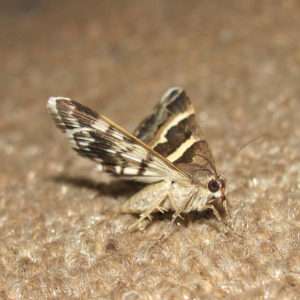

- 7. Fleas:
- Residual Insecticides: Spraying insecticides on affected areas such as pet bedding, carpets, or furniture. We never require any prep work of any kind. So if there is anything that needs to be done or moved, typically the techs do that (within reason). If there is anything you need to do, the tech will let you know for a follow-up visit.
- Fogging or Misting: The technician may apply insecticidal fog or mist in severe infestations. But more likely, the technician will dust in wall voids to rid your home of fleas in the hard to reach areas.
- 8. Spiders:
- Web Removal: Our technicians take great care in removing spider webs and egg sacs from the exterior of your home and in your garage space. Please note that we do not remove spider webs from the interior of your home. That would be a job for a cleaning crew.
- Insecticides: Finally, the technician will apply insecticides to areas where spiders are commonly found. This is usually in the basement or in closets and in the top corners of the rooms. Spiders can be hard to treat due to their long legs. If they walk over a chemical, their legs are so long it doesn’t affect them! And they are not grooming insects, so their legs rarely touch their bodies. We strive to treat the harborage areas where they will curl up in their nests so the insecticides will come in contact with their bodies.
- An exterior spray is the most effective when it comes to spiders.
- 9. Ants:
- Inspection: The technician first inspects to make sure that the type of ant is treated by bait or by spray or by both.
- Baiting: The technician will use ant baits that are carried back to the colony to eliminate it at the source. This is not Terro or Raid. These over-the-counter products may say they eliminate the whole colony, but they often don’t. It is best to have a licensed pest control technician treat.
- Barrier Treatments: The technician may apply residual insecticides around the structure to prevent ant entry. Pavement ants and Pharaoh ants may require a barrier treatment, whereas carpenter ants always require an exterior barrier treatment.
- Just like how some pests spread and transfer from home to home, is actually how we kill some species of pests, like carpenter ants: the products we spray, come off on insect legs, and they infect the rest of the colony! Pest Control Technology breaks down the science of the pest control products’ effects.



These treatments vary based on the severity of infestation, the specific pest species involved, and the environment being treated. Licensed pest control technicians tailor their approach to effectively eliminate pests while ensuring the safety of residents and pets.
For more tips and tricks regarding invasive pests, check out our category within our blog.
Do you get your holiday items second-hand? If so, check out our related article about getting rid of bugs in Christmas trees.
All of these pest issues except the bed bugs are included in our Peak Seasons Plan. Check out that comprehensive service in this video here!
Conclusion & Next Steps
Thank you for reading our article on the 9 invasive pests in second-hand items. You learned a lot about how pests transfer homes, how buying used furniture can result in infestation of pests, you learned 9 common hitchhiking pests, how bed bugs get transmitted and cockroach infestations happen; finally, you learned the importance of preventing pest spread and avoiding infested furniture.
For the best, most comprehensive pest control services, contact Done Right Pest Solutions at 651-342-9489 or email us at donerightpestsolutions@gmail.com.
We look forward to serving you,
Done Right Team
Have you ever had any of these 9 invasive pests from second-hand furniture? They can be so annoying! Did you use any of the tips we mentioned in this article, or other tips? We would love to hear about what worked for you!
Want to learn more tips and tricks regarding pest control? We offer tailored content! Subscribe to our free email newsletter.

